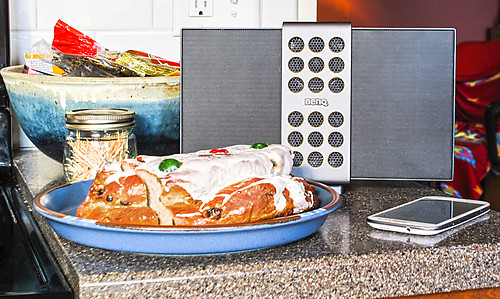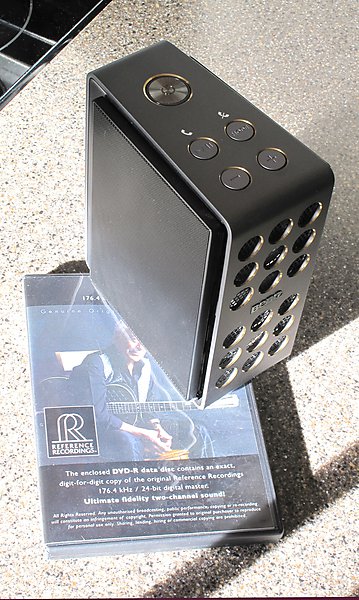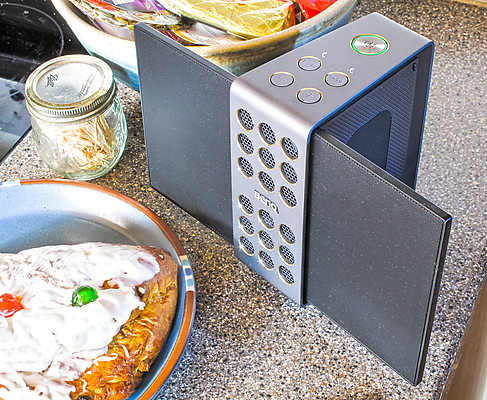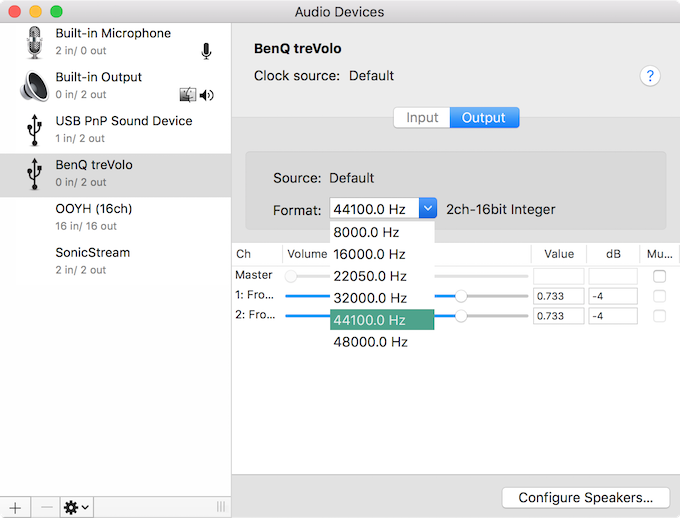BenQ treVolo Portable Electrostatic Speaker
Around our home, it still feels a lot like the year end holidays. With piles of snow in the back yard, ice storms rolling across the northern States, and a Christmas tree still gracing a corner of the living room, the holiday will be with us for a while longer. Along with the tree, I’ve been living with a small but exciting powered speaker system that redefines clarity and versatility on the desk top.
BenQ is known for their video monitors and projectors, and less so for their other computer peripherals and industrial signage. Their wireless speakers division has only a single product…the treVolo portable. What makes treVolo truly unique is not the awards it’s garnered, its Bluetooth 4.1 aptX connectivity, its line output for expansion nor its built–in microphone for taking calls. What makes treVolo the kewl kid on the block is its hybrid transducer array.

BenQ’s treVolo, in its natural element with other holiday treats
BenQ touts treVolo as “the world’s first portable electrostatic speaker,” available with “…the same electrostatic technology as high-end living room speakers.” Electrostats are all the rage at present, with Shure and Warwick Audio Technologies selling two new, exceptionally high fidelity headphone offerings that, to my ears, beat the pants off the old-school stuff from Koss and Stax. I’m not sure why BenQ invested their R&D in this, their sole example using the technology, but I’d guess that the product champions were so good at selling their harebrained idea to The Suits that they let them run with it.
Weighing in at just over 2.6 pounds, treVolo employs two true electrostatic panels, hinged for easy transport on either side of a two microspeaker “subwoofer” array. The 4″ by 6″ rectangular true electrostats are polarized with 200 VRMS, flanking dual 1.75″ midrange cones with NdFeB magnets in a vertical stack. The panels work below 20kHz, crossing over to a direct radiator array around 1kHz. Perpendicular to the electrostatic panels and cones are dual 3.75″ by 2″ oblong passive radiators. DSP is employed for EQ and active limiting, to sculpt the subjective timbre and prevent any over–excursion of the panels. Because of it’s battery powered, portable and often handheld nature, BenQ uses a modest 200 VDC polarizing voltage for those panels. The battery pack is rechargeable Li–ion chemistry.
On the top of the unit, there’s a power button about the size of a US quarter coin, plus and minus volume buttons, a play/pause/take call button and finally, a Sound Mode/end call button. A built-in microphone is hiding in the bottom right corner for the speakerphone function.

Once prepped for transport, treVolo is the size of a 3″ thick Blu-ray case
Surrounding the power button is a ring–shaped LED indicator, revealing the current Sound Mode state. treVolo has three modes, or instant EQ curves, accessible via a dedicated Mode button, which they call Pure (green indicator), Warm (red indicator), and Vivid (blue indicator). I would describe them as neutral or subjectively flat in Pure mode, broadband tilted up in Vivid mode, and broadband tilted down for Warm mode. Those two settings that diverge from flat are tastefully done, not smack–you–upside–the–head tone profiles. Even the tilted up setting is not too bright for extended listening, and would be perfect if you have the unit tucked against an acoustical boundary, listening off–axis or from a distance.

treVolo’s top is where most of the controls are located. Pure mode is indicated by the green lit bezel surrounding the power button.
treVolo has a built in limiter, I would think as much to prevent distortion and voice coil heating as to preserving battery life. The limiter can be heard if you send it too much bass–heavy material, where the overall spectral balance shifts as the system protects itself. This first occurred shortly after receiving my review unit…With it plugged in to mains power and the volume not set to maximum, I pulled up TIDAL and played The Wheel by Brit producer SOHN off his debut 4AD album Tremors via the line input. The song starts with a sampled intro and a capella vocals, then a deep bass synth line comes in. When the synth bass arrived, the limiter kicked in, noticeably dropping the level of the midband, including the vocals. This behavior underscores a key difference between treVolo and the vast majority of portable Bluetooth speakers on the market. treVolo is all about quality, not quantity. Its all metal construction and high fidelity approach to music reproduction flies in the face of the muddy yet tizzy posers sitting on the shelves of your favorite retailer.
The mid/woofers are each driven by 5W amplifiers, while the two electrostatic panels are driven by 3W amps. All four are Class D. To give you some idea of just how loud it goes, I set up the gain staging. First, I generated a 400 Hz 96 kHz triangle wave, a signal rich in both high and low components. Then, I adjusted the signal generator’s output to just below clipping. Feeding the line input of the treVolo set to max gain, I switched to pink noise and took a measurement. From one meter away I got, on average, a reading of 85 dBSPL A weighted. That’s plenty loud enough for an average room but, it would fall way short in a crowded party environment where you want to suppress conversation and get people up off their booties. Sitting next to the system in my office, it can easily play too loud for sustained listening. BenQ specs 12 hours of play time, and I handily exceeded that on batteries with an average of 14 hours at decent levels with a variety of program material from TIDAL. Truth be told though, it spends most all of its time plugged into its included wall wart PSU.
Despite the Bluetooth 4.1 with aptX, I also rarely use the wireless feature. Yes, the Bluetooth implementation is as good as any of the other wireless gadgets I have around the house and, yes, treVolo displays a singular multicolored LED sequence when you hold down the dedicated Bluetooth button on the back to begin pairing. That said, I’m an audio guy, and that means a hard wired connection when possible. Along with the line in, a line level output allows you to get some real low frequency performance. Throw a bit of dough at the problem and you could mate Polk Audio’s 10″ PSW 108, Yamaha’s 8″ YST-SW012 or Pioneer’s slightly more upscale SW-8MK2 powered subwoofer to the treVolo for when you’re parked in your home office.
In addition to the analog I/O, the treVolo has a serviceable albeit unexciting USB DAC with a Micro USB input. Connected to my MacBook Pro, it was plug and play, showing up with a surprisingly low fidelity range of sample rates.

The treVolo as seen from Audio MIDI Setup
Checking the BenQ web site, I found no drivers for Windows or Linux so, if your stuck in either of those environments, it seems your out of luck for a USB hookup. My advise would be to simply use Bluetooth or analog.
System frequency response is specified as 60 Hz to 20 kHz. Not tolerances were provided by BenQ but, when measured, the output started to roll at about 140 Hz at the low end and 18.5 kHz at the top. In subjective terms, output remains strong at 80 Hz, and really starts to roll at 70. By 60 Hz, the output is significantly attenuated. The output of a sine wave just below clipping at 80 Hz is about 20 dB down compared to the same signal at 400 Hz.
treVolo has good horizontal coverage but quite narrow vertical high frequency directivity. To fully appreciate those dual mid–high panels, you need to basically keep them at ear level or you can dial in the HF lift EQ. Being panels, the treVolo is a bidirectional radiator, which means it works well centrally located in a room. If you’re trapped in a cubicle all day, the absorptive nature of open office walls are perfect for knocking down the rear output. With its small footprint, folding compact design, and ability to serve as a hands–free adjunct to your phone, treVolo is the ideal office audio cube mate.
BenQ pitches the treVolo as being “…precisely tuned with a custom DSP to deliver truly uncompromising sound for compelling audio enjoyment.” While I would quibble with the uncompromising aspect of that marketing copy, I can agree that this little beast provides absorbing audio enjoyment in a very sturdy and well made package. It is the perfect gift for the music–obsessed cube denizen in your life.
If all you listen to is EDM or organ recitals at ear–fatiguing volumes, then the treVolo alone is not a good choice. Graft on a compact sub, however, and you’ve got a wonderfully cost effective, high fidelity system that will serve most folk’s hi–fi needs. On the other hand, if you’re more inclined to enjoy nearfield listening with low distortion, extended frequency response and a range of voicing options, then I cannot think of a better portable audio system all by itself. Add in the ability to feed the output into a full range system, the wireless hands–free connectivity, the solid fabrication and the competitive price, and you’ve got a winning combination that would make even a die hard audiophile happy.
Product information
- Manufacturer: BenQ Corporation
- treVolomusic.com
- benqdirect.com
- $299 list, $199 street
Additional Gear Used for This Review
- Sources: Amarra Symphony 3.0 w/iRC, Amarra for TIDAL 2.2
Music in Heavy Rotation During This Review
- Mitski Miyawaki — Puberty 2 (Dead Oceans 2016). At times tuneful, with intrusions of jagged grrrl power, Mitsky crafts a lyrical, sly, compelling document.
TIDAL artists worth a listen…
- William Tyler – modern Country
- Nicholas Payton – horny Jazz
- Black Prairie – Americana
- Andy Shauf – shoegazey Pop
- Bomba Estéro – Latino pop
- Broken Bells – Pop super group
- Budapest Festival Orchestra, Iván Fischer – duh
- Cold War Kids – poppy Rock
- Iris Dement – awesome Americana
- Ian William Craig – vibey psychoPop



